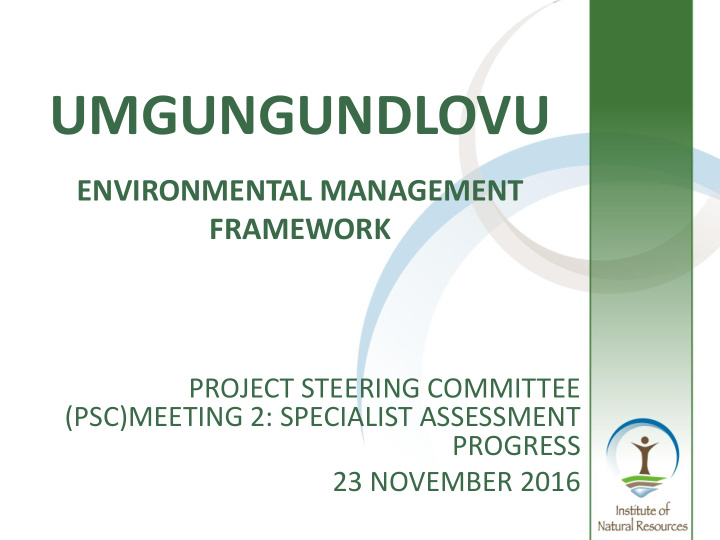



UMGUNGUNDLOVU ENVIRONMENTAL MANAGEMENT FRAMEWORK PROJECT STEERING COMMITTEE (PSC)MEETING 2: SPECIALIST ASSESSMENT PROGRESS 23 NOVEMBER 2016
AGENDA 1. WELCOME 2. APOLOGIES 3. SPECIALIST ASSESSMENT 3.1 Landcover Mapping 3.2 Agricultural Resources Assessment 3.3 Water Quality 3.4 Flood Risk Assessment BREAK FOR TEA 3.5 Wetland Assessment 3.6 Water Yield 3.7 Biodiversity Assessment 4. WAY FORWARD 5. MEETING CONCLUSION
PROGRESS OVERVIEW: SPECIALIST ASSESSMENT
LANDCOVER MAPPING • KZN landcover (2011) used as the base map • Manually refined to provide accurate landcover data in the KFA’s
AGRICULTURAL ASSESSMENT • Land cover and land potential for the District has been collected and has been used for mapping areas of high agricultural potential • KFAs – Desktop land cover refinement completed – Land capability information from KZNDARD also available for KFAs in GIS format – KZNDARD have undertaken to provide data from field-based land capability surveys in KFAs to assist ground-truthing • Agrobiodiversity data still to be acquired from EKZNW & KZNDARD – dataset still being refined. • Detailed ground truthing of grassland and soil type not feasible due to high degree of heterogeneity – will make use of existing data as much as possible, and will apply a focused ground truthing process with other specialists working on the project.
WATER QUALITY • ALARM model re-configured to quinnary catchment scale – Includes flow sequencing, land cover summary etc. per quinnary • Sensitivity analysis (Ecological and Priority resources i.e. dams) • Point source identification and capture undertaken • WARMS data extracted and summarized per quin where possible • Mapping of WQ point catchments and NB determinants
FLOOD RISK ASSESSSMENT • Investigation of Human Settlements tool (FRIS) recommended by PSC • This was carried out and found to be most efficient flood risk assessment tool for large areas • 1:100 yr flood line completed and illustrated in the following map. • 1:20 and 1:50 yr flood areas in process and will be ready by end of the month.
WETLAND MAPPING – DESKTOP COMPONENT Mapping Wetlands within the KFAs • A collaborative approach has been taken: – CSIR: The CSIR have a dedicated technician / intern mapping wetlands (extent & condition) throughout the UMDM as part of the revision to the National Wetland Map (GEF 5 funded project). They have agreed to map the KFAs first. – WWF: Vaughan Koopman and Damian Walters mapped wetlands (extent & condition) in large portions of the upper reaches of the UMDM as part of a WWF project. – SANBI: Richard Lechmere-Oertel is currently working on a forestry project which requires the mapping of wetlands (only extent at this stage, condition still to be determined) throughout sections of the UMDM. – INR: The INR team will apply the predictive wetland model and undertake a desktop mapping validation process within the KFAs. Mapping Wetland throughout the UMDM • The existing provincial wetland layer & the predictive wetland model. • Should the CSIR project be completed in time their mapping of wetlands throughout the UMDM will also be incorporated into the final wetland spatial layer for the entire municipality.
Byrne KFA Example of the mapping being undertaken for all of the KFAs. The digitized layer reflects an improved understanding of wetland extent throughout and where required adjacent to the KFA, in comparison to the existing provincial wetland layer and the wetland probability layer .
Wetland layer for the UMDM Preliminary modelled layer vs. existing provincial layer. The conservative modelled layer highlights the possible underrepresentation of the existing provincial layer. Hopefully the CSIR product will further improve the wetland spatial layer for the entire UMDM.
WETLAND MAPPING – PROGRESS & WAY FORWARD • CSIR aims to map the entire UMDM. To date, all the KFA’s have been mapped, apart from the Cleopatra KFA. • SANBI & WWF spatial layers have already been shared with the INR. • Desktop validation still needs to be completed. • The Desktop mapping component will be completed by the end of the year. • The infield verification component will be completed early in the new year. • The wetland component will be completed by February 2017
INFRASTRUCTURE ASSESSMENT • Currently using available data to identify areas lacking in infrastructure (Roads, Electricity and water reticulation) • We have omitted bulk service infrastructure (PSC to comment?) • Collecting the Water and Sanitation assets database to improve this • Workshop planned to bring together Infrastructure Unit people to discuss condition
Progress • Agri-Bio Zones and corridor mapping - still to be finalised to update the UMDM BSP • Incorporation of new spatial data from EKZNW • Align EMF guidelines with KZN Norms and Standards/constraints mapping • uMngeni Greater Biosphere Reserve • Ground-truthing of KFAs - desktop and infield
2011 Land Cover
Untransformed Land
Untransformed (PAs removed)
Critical Biodiversity Areas (CBAs)
Ecological Support Areas (ESAs)
Other Natural Areas
Key Focus Areas (KFAs) Unsuitable for development Restricted development Suitable for development?
Water Yield
Modelling Water yield Quinary catchment data (Streamflow) ACRU Hydrological Model Water yield Land cover map (EKZNW 2011) (Baseflow) Translate into Total water ACRU supply Different land “ Hydrological cover types R esponse Units” e.g. or HRUs Sustained dry- plantations, season flow grassland, alien plants
Quinary Catchments
2011 Land Cover
Hydrological Response Units (HRUs)
Progress Modelling in progress Completed Largely complete through UEIP
WAY FORWARD • Finalize refined mapping by Dec 2016 • Ground truthing between Jan – Feb 2017. • Draft EMF Report: March 2017 • DST : March 2017 • Final PSC Meeting & Public Meeting /Comment: March/ April • Final EMF Report & DST: May – June 2017
Recommend
More recommend